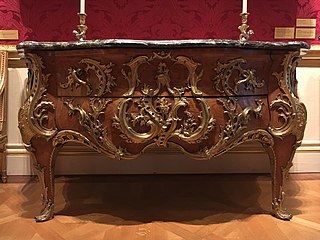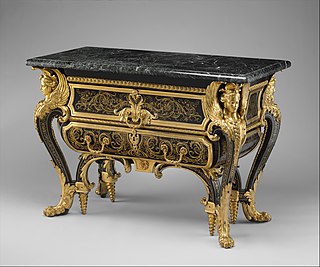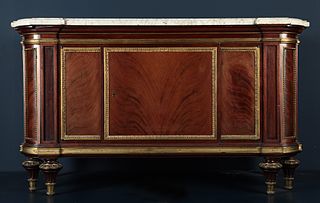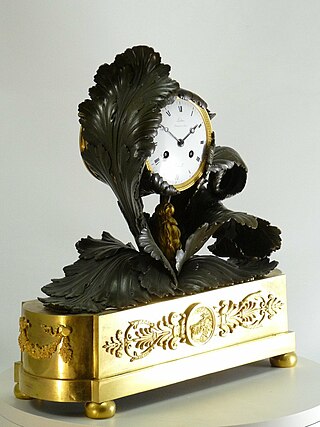
Jean-François Oeben, or Johann Franz Oeben was a German ébéniste (cabinetmaker) whose career was spent in Paris. He was the maternal grandfather of the painter Eugène Delacroix.

Abraham-Louis Breguet, born in Neuchâtel, then a Prussian principality, was a horologist who made many innovations in the course of a career in watchmaking industry. He was the founder of the Breguet company, which is now the luxury watch division of the Swiss Swatch Group.

Jean-Henri Riesener was a famous German ébéniste (cabinetmaker), working in Paris, whose work exemplified the early neoclassical "Louis XVI style".

The Bureau du Roi, also known as Louis XV's roll-top desk, is the richly ornamented royal cylinder desk which was constructed at the end of Louis XV's reign, and is now again in the Palace of Versailles.

The French Crown Jewels and Regalia comprise the crowns, orb, sceptres, diadems and jewels that were symbols of Royal or Imperial power between 752 and 1870. These were worn by many Kings and Queens of France as well as Emperor Napoleon. The set was finally broken up, with most of it sold off in 1885 by the Third Republic. The surviving French Crown Jewels, principally a set of historic crowns, diadems and parures, are mainly on display in the Galerie d'Apollon of the Louvre, France's premier museum and former royal palace, together with the Regent Diamond, the Sancy Diamond and the 105-carat (21.0 g) Côte-de-Bretagne red spinel, carved into the form of a dragon. In addition, some gemstones and jewels are on display in the Treasury vault of the Mineralogy gallery in the National Museum of Natural History.

Ormolu is the gilding technique of applying finely ground, high-carat gold–mercury amalgam to an object of bronze, and objects finished in this way. The mercury is driven off in a kiln, leaving behind a gold coating. The French refer to this technique as "bronze doré"; in English, it is known as "gilt bronze". Around 1830, legislation in France outlawed the use of mercury for health reasons, though use continued to the 1900s.

The Empire style is an early-nineteenth-century design movement in architecture, furniture, other decorative arts, and the visual arts, representing the second phase of Neoclassicism. It flourished between 1800 and 1815 during the Consulate and the First French Empire periods, although its life span lasted until the late-1820s. From France it spread into much of Europe and the United States.

Jacques Caffieri was a French sculptor, working for the most part in bronze.

André-Charles Boulle, le joailler du meuble, became the most famous French cabinetmaker and the preeminent artist in the field of marquetry, also known as "inlay". Boulle was "the most remarkable of all French cabinetmakers". Jean-Baptiste Colbert recommended him to Louis XIV of France, the "Sun King", as "the most skilled craftsman in his profession". Over the centuries since his death, his name and that of his family has become associated with the art he perfected, the inlay of tortoiseshell, brass and pewter into ebony. It has become known as Boulle work, and the École Boulle, a college of fine arts and crafts and applied arts in Paris, continues today to bear testimony to his enduring art, the art of inlay.

Antoine-Robert Gaudreau was a Parisian ébéniste who was appointed Ébéniste du Roi and was the principal supplier of furniture for the royal châteaux during the early years of Louis XV's reign. He is largely known through the copious documentation of the Garde-Meuble de la Couronne; he entered the service of the Garde-Meuble in 1726. However, since his career was spent before the practice of stamping Paris-made furniture began (1751), no stamped piece by Gaudreau exists and few identifications have been made, with the exception of royal pieces that were so ambitious and distinctive that they can be recognized from their meticulous inventory descriptions.

Louis-Simon Boizot (1743–1809) was a French sculptor whose models for biscuit figures for Sèvres porcelain are better-known than his large-scale sculptures.
Gilles Joubert (1689–1775) was a Parisian ébéniste who worked for the Garde-Meuble of Louis XV for two and a half decades, beginning in 1748, earning the title ébéniste ordinaire du Garde-Meuble in 1758, and finally that of ébéniste du roi on the death of Jean-François Oeben in 1763. He produced case furniture in a robust Rococo style, ranging from simple veneered bidets to grand commodes that integrated gilt-bronze mounts into the forms of furniture with subtle three-dimensional curves (bombé). From the later 1760s his furniture increasingly shows a conservative compromise with the nascent neoclassical style.

Pierre-Philippe Thomire (1751–1843) a French sculptor, was the most prominent bronzier, or producer of ornamental patinated and gilt-bronze objects and furniture mounts of the First French Empire. His fashionable neoclassical and Empire style furnishing bronzes established the highest standard in refined finish in the craft that the French called that of the fondeur-ciseleur, "founder-finisher". In his pre-Revolutionary training, Thomire appeared first as a ciseleur, in the division of duties that went into the production, for example, of a set of gilt-bronze wall-lights delivered for Marie-Antoinette's card-room, her Salon des Jeux at Compiègne: under the general supervision of Hauré, the wax and wooden model was carved by Martin, cast by Forestier, and chased by Thomire, as Pierre Verlet was able to show over fifty years ago.

The Hôtel de la Marine, also known (formerly) as the Hôtel du Garde-Meuble, is an historic building on the Place de la Concorde in Paris, just east of Rue Royale. It was designed by the architect Ange-Jacques Gabriel and built between 1757 and 1774 on the newly created square first called Place Louis XV. The identical building across the street, constructed at the same time, now houses the Hôtel de Crillon and the Automobile Club of France.

Guillaume Beneman or Benneman was a prominent Parisian ébéniste, one of several of German extraction, working in the early neoclassical Louis XVI style, which was already fully developed when he arrived in Paris. Beneman arrived in Paris already trained; he was settled in the rue du Faubourg Saint-Antoine when he was received master in 1785 by royal command. He rapidly became the last of the royal cabinet-makers before the French Revolution, working under the direction of the sculptor-entrepreneur Jean Hauré, fournisseur de la cour.

Bernard II van Risamburgh, sometimes Risen Burgh was a Parisian ébéniste of Dutch and French extraction, one of the outstanding cabinetmakers working in the Rococo style. "Bernard II's furniture is brilliant in almost every respect. His carcasses are beautifully shaped, his mounts and marquetry are always in complete balance even when extremely elaborate, and there is a logic to his works that allows the eye to comprehend them effortlessly," wrote Ted Dell.

Jean-Pierre Latz was one of the handful of truly outstanding cabinetmakers (ébénistes) working in Paris in the mid-18th century. Like several of his peers in the French capital, he was of German origin. His furniture is in a fully developed rococo style, employing boldly sculptural gilt-bronze mounts complementing marquetry motifs of flowers and leafy sprays, in figured tropical veneers like tulipwood, amarante, purpleheart and rosewood, often featuring the distinctive end-grain cuts. He also produced lacquered pieces, most famously the slant-front desk in the collection of Stavros Niarchos, Paris.

Antoine Cronier, or Crosnier, was a noted clockmaker active during the second half of the 18th century in Paris, France.

Louis XVI furniture is characterized by elegance and neoclassicism, a return to ancient Greek and Roman models. Much of it was designed and made for Queen Marie Antoinette for the new apartments she created in the Palace of Versailles, Palace of Fontainebleau, the Tuileries Palace, and other royal residences. The finest craftsmen of the time, including Jean-Henri Riesener, Georges Jacob, Martin Carlin, and Jean-François Leleu, were engaged to design and make her furniture.

Pierre-Victor Ledure, (1783–1840?) was a French marchand-fabricant (merchant-manufacturer) of bronzes, specialising in ormolu clock cases. He often worked together with the clockmaker Claude Hémon (1770–1820), who supplied the clockworks. Ledure's workshop is listed in Paris between 1813 and 1840, first in the Rue Neuve-des-Petits-Champs, then in the Rue Vivienne and finally in the Rue d'Angoulême.
"The Empire clock, like the furniture, adopts a monumentality, a robustness, one can even say a severity, which radically distinguish it from the works of the 18th century. The shapes become simpler, stiffer and, often, heavier."






















